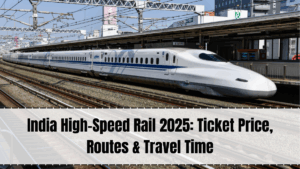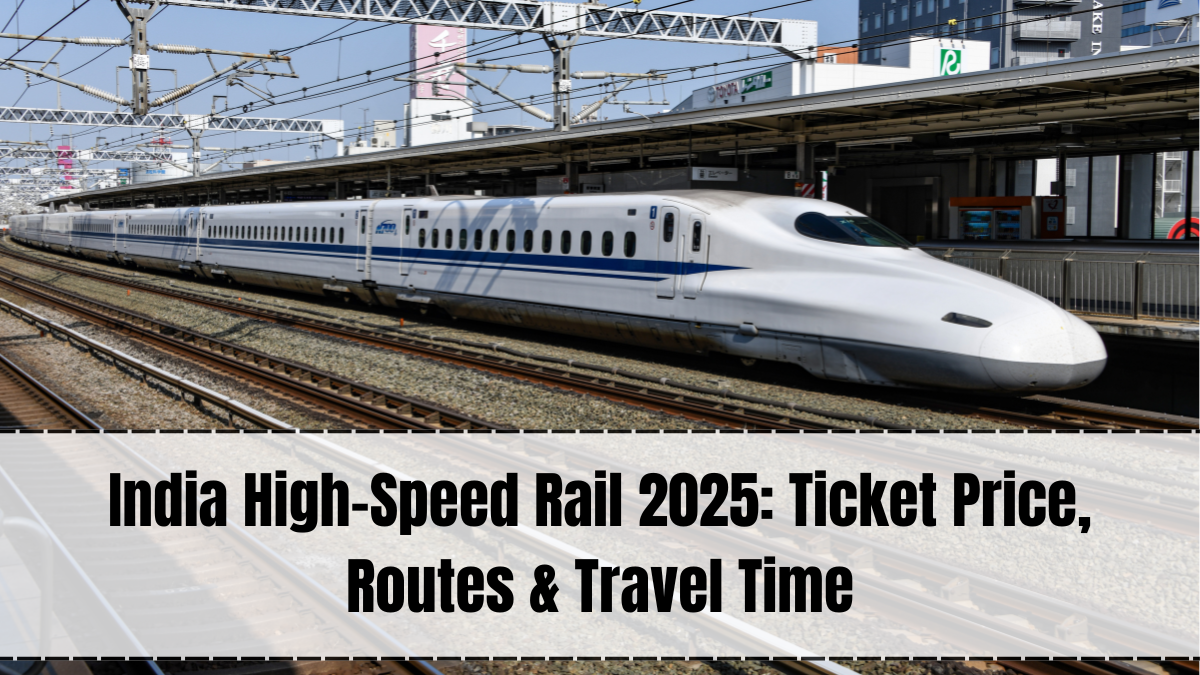The year 2025 marks a significant milestone for India’s transport infrastructure as the country advances its high-speed rail projects. From the Mumbai-Ahmedabad Bullet Train nearing trial runs to upcoming proposals connecting major metropolitan cities, India is firmly stepping into the future of fast and efficient passenger transport. High-speed rail will not only save travel time but also boost regional connectivity, business, and tourism.

Table of Contents
What is India’s High-Speed Rail Project?

India’s high-speed rail (HSR) network aims to connect major economic and cultural hubs with trains capable of operating at speeds of 250–350 km/h. Unlike conventional railways, HSR requires dedicated corridors, advanced signalling systems, and specially designed rolling stock. The flagship project, the Mumbai-Ahmedabad corridor, is the first of several planned high-speed lines.
Key High-Speed Rail Routes in Development (2025 Onwards)
Several routes are being prioritized under the High-Speed Rail vision:
-
Mumbai–Ahmedabad Corridor
-
Distance: 508 km
-
Status: Under construction, trial runs expected in 2025
-
Technology: Japanese Shinkansen E5 series
-
-
Delhi–Varanasi Corridor
-
Distance: 865 km
-
Proposed stops include Agra, Lucknow, Prayagraj
-
Status: Feasibility studies in progress
-
-
Delhi–Ahmedabad Corridor
-
Distance: ~875 km
-
Expected to connect through Jaipur and Udaipur
-
-
Chennai–Mysuru Corridor
-
Distance: 435 km
-
Status: DPR under preparation
-
-
Mumbai–Nagpur Corridor
-
Distance: 753 km
-
Aims to boost connectivity between Maharashtra’s capital and central India
-
Ticket Prices for High-Speed Rail
While final fares may vary, initial estimates suggest that high-speed rail in India will be priced competitively with air travel for similar distances.
| Route | Class | Expected Fare (One Way) |
|---|---|---|
| Mumbai–Ahmedabad | Standard | ₹3,000 – ₹3,500 |
| Executive | ₹6,000 – ₹7,000 | |
| Delhi–Varanasi | Standard | ₹4,500 – ₹5,500 |
| Chennai–Mysuru | Standard | ₹2,500 – ₹3,000 |
Fares will vary depending on class, distance, and additional services provided onboard.
Benefits of High-Speed Rail for India
The India High-Speed Rail 2025 network is expected to bring multiple advantages:
-
Time Savings: Reduce travel time by 50–70% between major cities
-
Economic Growth: Boost trade, tourism, and business connectivity
-
Environmental Impact: Encourage a shift from road and air travel, reducing CO₂ emissions
-
Job Creation: Generate thousands of direct and indirect employment opportunities during construction and operation
-
Urban Development: Lead to growth of satellite towns around new HSR stations
Technology & Safety Features
India’s HSR corridors will adopt state-of-the-art technology to ensure smooth and safe operations:
-
Dedicated Tracks: Prevent interference from slower trains
-
Automatic Train Control (ATC): Real-time monitoring of train speed and safety
-
Seismic Sensors: Immediate train halting in case of earthquakes
-
Noise Reduction: Aerodynamic train designs to minimize sound pollution
Challenges Faced
While progress is strong, certain challenges remain:
-
Land Acquisition: Securing large tracts of land for dedicated tracks
-
Funding: High initial investment costs
-
Skill Development: Need for training Indian engineers in high-speed rail operations
-
Integration: Ensuring smooth transition between high-speed and conventional rail networks
Timeline & Future Plans
-
2025: Mumbai–Ahmedabad corridor trial runs begin
-
2026–2030: Delhi–Varanasi, Mumbai–Nagpur, and Chennai–Mysuru corridors expected to start construction
-
Post 2030: Expansion towards an interconnected national high-speed rail grid
How Passengers Can Prepare
Once operational, the booking process will be similar to air ticketing, with options for online booking via IRCTC, mobile apps, and dedicated station counters. Passengers will need to:
-
Carry valid ID proof
-
Arrive early for security checks
-
Pre-book for peak travel seasons to secure the best fares
FAQs
Which is India’s first high-speed rail project?
The Mumbai–Ahmedabad Bullet Train is India’s first high-speed rail project.
What is the top speed of high-speed trains in India?
Trains are designed for speeds up to 350 km/h, with operational speeds around 320 km/h.
Will ticket prices be affordable?
Yes, fares are expected to be competitive with low-cost airlines for similar routes.
When will India’s high-speed rail network be fully operational?
The first section is expected in 2026, with nationwide expansion by 2035.
What technology is used in India’s bullet trains?
Japanese Shinkansen technology is being adapted for Indian conditions.
Click here to know more.






